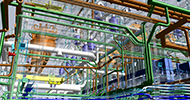Inspection processes are performed to measure, evaluate and audit purchased components and raw materials before they’re used in production. In theory, this inspection process should be an efficient way to ensure the quality of the parts and detect nonconformities before they impact production or consumers.
However, at the majority of manufacturing sites, the incoming inspection process is far from optimal. Instead, it’s costly, inefficient and laborious, and substantial waste can often be found. Fortunately, there are a number of ways to reduce the overall cost of quality as it relates to the incoming inspectionprocess, which will extend financial and productivity benefits throughout the organization. Here’s how to get started:
1. Establish a strategic inspection plan. Establish procedures for critical quality attributes to ensure that money isn’t wasted inspecting non-critical features. Alter this plan when you detect a defect, and scale back inspection measures as needed depending on the results. Updating the inspection plan in this way will prevent the organization from wasting money over the life of the component.
2. Collaborate with suppliers. Let the suppliers know which features you’re going to evaluate during incoming inspection. Inmost cases, they’ll respond by verifying those features before shipping the components to your site. This improves efficiency by making quality everyone’s responsibility.
3. Qualify components before launch. Insist that all components must be qualified before the part is launched. Otherwise, rejections will occur throughout the product lifecycle, costing the company time and money to return the nonconforming parts to the supplier.
4. Confirm that only nonconforming parts are returned. In many organizations, acceptable parts are mistakenly returned to the supplier. Upon receipt, the supplier evaluates the rejected shipment and discovers that the components meet quality standards. This leads to considerable waste, including shipping costs, additional inspection costs and line downtime. Fortunately, this can all be prevented by implementing a system that confirms the condition of the parts before they are returned.
As supply chains become more complex, it will be even more important for companies to streamline the incoming inspection process. Doing so can save countless hours and untold financial resources, while driving efficiencies throughout the organization. For more tips, click here to learn how one company implemented a 3D measurement solution to optimize the performance of their inspection process.














